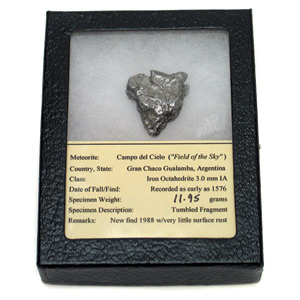 by: Ken Byrne
by: Ken Byrne
How many people have been struck by meteorites falling from the sky? The fact of the matter is that we all have been…repeatedly! While injuries from fallen meteorites of significant size are extremely rare, falling all around us and onto us each day are the meteorites smallest siblings, micrometeorites.
Pieces of rock and metal frequently collide with Earth’s upper atmosphere. Most of these are no bigger than a golf ball but are traveling at tens of thousands of kilometers per hour. The atmosphere is very thin at this altitude of 80 to 100 kilometers (50 to 62 miles), however, it creates enough friction to cause these travelers from space to heat up to temperatures that make them burn brightly. These are the fireballs in the sky that are rightly called meteors, although they are often referred to as “shooting stars.”
Most meteors burn up completely in the atmosphere and never reach the ground. Those that survive the trip and reach the surface of Earth are called meteorites. While it is generally believed that meteorites are fairly rare, in reality about 30,000 tons of extraterrestrial material are deposited on Earth each year; bits of comets, chunks of asteroids, debris from the formation of our solar system more than four billion years ago. So why aren’t meteorites seen more often sitting on the ground? First of all, the largest portion of this material falls into the oceans, and secondly, most of the material that reaches the surface is microscopic, much too small to be noticed. These are the tiny specimens known as micrometeorites. As tons of micrometeorites fall each year, they gently land in our fields, on our homes, and on us.
One of the best places to study micrometeorites is Antarctica. In this isolated environment, very little earth-born debris falls, so any particles found on the clean South Pole ice have a greater likelihood of being extraterrestrial. In fact, what may be the largest collection of micrometeorites is in the hands of the Cold Regions Research and Engineering Laboratories.
Since most of us can’t arrange a field trip Antarctica, here is a way that you can collect micrometeorites in your hometown with the help of the rain. Micrometeorites falls everywhere, but collect very nicely on roofs. When rain falls, this “space dust” is washed off the roof and through the downspouts. Position a deep bowl or bucket under a downspout. Many things will collect in your bucket; leaves, twigs, sands, etc. Collect this material from your bucket and dry it out. Remove the larger pieces of debris, such as leaves, and spread the remaining material on a sheet of paper (or plastic). Slowly run a strong neodymium magnet back and forth under the paper. (Note: Whenever using a neodymium magnet to collect particles, it’s always a good idea to place it in a plastic bag to keep it clean.) When you feel you have attracted most of the metallic particles, tilt the paper up so that the non-ferrous materials fall from the sheet.
 Much of what you have collected will be Earth born debris. To find the micrometeorites you will need to examine the collected particles under a microscope. High power will be required to see them clearly. Look for particles that are rounded and may have small pits on their surface. This is evidence of a micrometeorite’s fiery trip through the atmosphere.
Much of what you have collected will be Earth born debris. To find the micrometeorites you will need to examine the collected particles under a microscope. High power will be required to see them clearly. Look for particles that are rounded and may have small pits on their surface. This is evidence of a micrometeorite’s fiery trip through the atmosphere.
 If you are ever interested in obtaining larger meteorite fragments, Educational Innovations offers three different varieties. We have Sikhote-Alin, Campo del Cielo, and Nantan samples for sale on our website.
If you are ever interested in obtaining larger meteorite fragments, Educational Innovations offers three different varieties. We have Sikhote-Alin, Campo del Cielo, and Nantan samples for sale on our website.
I’m starting to work with a 1 1/2 yr old boy who loves rocks, thusly bringing them from outside to inside of the house, loosing them on the carpet for the vacuum to find, what racket, or to step on them bare feet or sock clothed, just the same as hard dog food, so I’m getting little plastic containers from the fishing supply section of store to contain his special rocks, he won’t get in trouble or yelled at, can you imagine that he would be discouraged from progressing towards what could be a lifetime occupation, geologist or Indiana Jones, so I thought it would be awesome for him to have space rocks also, only in due time when he can appreciate them. So how do I know that what I buy is not a scam and they are real space rocks?
Certificate of authenticity from US Government?